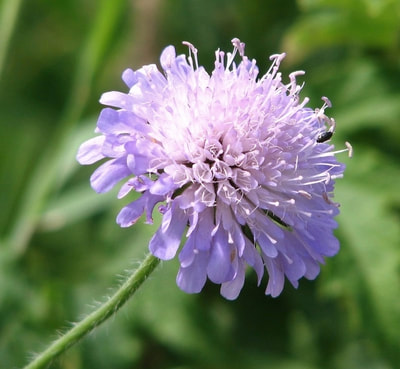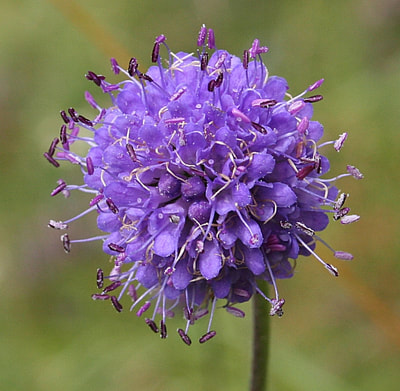|
Field Scabious Small Scabious Devil's bit Scabious Poetry of flowers- Scabious Knautia Arvensis
Perfect purple flowers of unfolding love, As buds unfurl they predict the direction of the heart. Each bloom a pin cushion of fifty flowers, Unfailing beauty covers the chalk downland. Untainted pure expression of long-lasting love, Scabious cures the itch of the unfailing heart. J.Huet 2017 Scabious is aptly named as a cure for the itch or scabies which also extends to other skin irritations including eczema. An ideal plant first for its beauty, then as a worthwhile food plant for caterpillars and moths and also to make skin-curing ointments. In the late spring the foliage can be steeped in oil in a sunny position to create an infusion of its valuable skin soothing properties. This oil mixed with beeswax will create a long-lasting ointment for the skin. This plant of dry fields, pastures and grass banks is a most attractive species, its beautiful flowers enlivening the grass swards. Young ladies would give a name to each bud on the plant and as they unfurl the most perfect flower would be chosen as their suitor given rise to the name ‘bachelors buttons’. Each flower is made up of fifty individual flowers which also gives the plant the folk name of pin-cushions and pins and needles which it resembles. A beautiful plant which has great value as a food plant for butterflies and moths and a source of nectar for many invertebrates. The male stamens actually wither before the female stigmas mature to avoid self-pollination. The seeds are distributed by ants and although goats and sheep will graze the plant, cattle dislike it. Other species Field scabious closest relative is the small scabious (Scabiosa columbaria) which as the name applies is a smaller species with more finely divided leaves. These fine leaves may be the reason it has the Latin name of ‘columbaria’ which is derived from dove or pigeon which may refer to its leaves resembling bird’s feet or its dove-coloured flowers. Its long roots spread deep into the soil of the dry chalk where it grows. Devil’s –bit scabious more compact flowers create an exuberant display for all to see. The Devil was so frustrated with all the ailments this plant cured he bit part of the root off, leaving it short to this day. However this species does not need long roots in the same way as the small scabious as it grows in wet areas across the country. If you wish to learn more please subscribe to our monthly newsletter or join us on a course where we can soak up the beauty and learn a deeper appreciation. May Nature continue to inspire you!
0 Comments
Leave a Reply. |
Details
Poetry of flowersJoin me to explore the flora of the British Isles on this blog. My intention is to attempt to capture the unique quality and beauty of each species of flower, tree or shrub. For every species featured I will be growing many more wildflowers to celebrate the joy of their existence, their intrinsic conservation value and bewildering array of uses. For nearly 30 years I have noted, studied and explored wildflowers in the field much to the patience of the walker beside me. To share this passion is a heartfelt plea to respect, preserve and care for all British Wildflowers no matter how common they seem. Archives
February 2024
Categories |




 RSS Feed
RSS Feed
